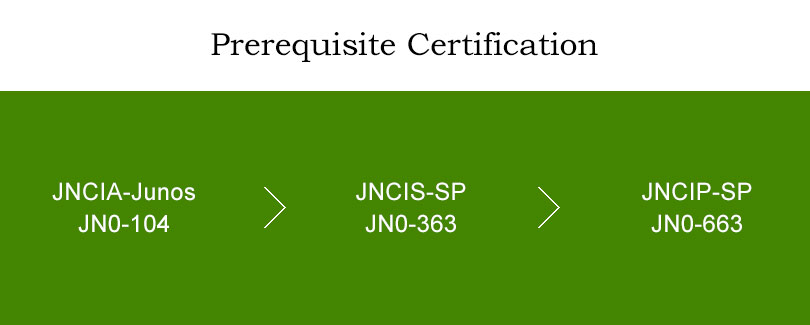
Juniper JN0-663 Dumps is the JN0-663 JNCIP-SP (Service Provider Routing and Switching, Professional) exam material for Juniper Professional level candidates.
You must know the prerequisites for taking the JN0-663 JNCIP-SP certification exam:
1. JNCIA-Junos(JN0-104)
2. JNCIS-SP(JN0-363)
3. JNCIP-SP(JN0-663)
If you meet the above requirements, you can then take the Juniper Professional JN0-663 JNCIP-SP certification exam.
leads4pass JN0-663 Dumps have been updated to include 96 exam questions and answers, reviewed by a team of experts, and truly cover all the questions in the JN0-663 JNCIP-SP certification exam.
So you just need to download JN0-663 Dumps https://www.leads4pass.com/jn0-663.html and practice all the target exam questions carefully to make sure you 100% successfully pass the JN0-663 JNCIP-SP certification exam.
Prepare for the JN0-663 JNCIP-SP certification exam by referring to the following Juniper JN0-663 exam information:
Vendor: Juniper
Exam Code: JN0-663
Exam Name: Service Provider Routing and Switching, Professional (JNCIP-SP)
Certification: JNCIP-SP
Exam Length: 120 minutes
Exam Type: 65 multiple-choice questions
Languages: English
Price: $400 USD
Passing score: (60-70% Approx.)
JN0-663 dumps: https://www.leads4pass.com/jn0-663.html (365 days Free Update)
Take the Juniper JN0-663 Online Practice Test:
Verify the answer at the end of the text
QUESTION 1:

You manage an MX Series device which includes the configuration shown in the exhibit.
Traffic marked with DSCP 000011 is entering the GE-1/0/4 interface at 102 Mbps.
The traffic exits the device on the ge1/0/5 interface.
No other traffic is transiting the router.
In this scenario, what happens to traffic exceeding 100 Mbps?
A. Traffic exceeding 100 Mbps is redirected to a rate limiter.
B. Traffic exceeding 100 Mbps is buffered.
C. Traffic exceeding 100 Mbps is dropped.
D. Traffic exceeding 100 Mbps is forwarded.
QUESTION 2:


R2 is receiving a route from an EBGP neighbor and is advertising the route to R4.
Referring to the exhibit, which configuration on R2 will solve the issue with the route on R4?
A. Move the no-advertise export policy from group 65002 to a global BGP policy.
B. Move the NHS policy from a global BGP export policy to an export policy under group 65002.
C. Move the no-export policy from a global BGP import policy to an import policy under group 65001.
D. Move the no-advertise export policy from group 65001 to a global BGP policy.
QUESTION 3:

Referring to the exhibit, which statement is true?
A. The BGP session between R1 and R2 will establish correctly and only the inet6 unicast NLRI will pass routing information.
B. The BGP session between R1 and R2 will fail to establish correctly due to an NLRI mismatch.
C. The BGP session between R1 and R2 will establish correctly and the net unicast and the inet6 unicast NLRIs will pass routing information.
D. The BGP session between R1 and R2 will establish correctly and only the net unicast NLRI will pass routing information.
QUESTION 4:

Referring to the exhibit, which two statements are correct for a route advertised by R1 towards R4? (Choose two.)
A. The BGP next hop is set to 14.1.1.1 by R2.
B. The AS path is set to 150 by R2.
C. The BGP next hop is set to 192.168.2.2 by R2.
D. The AS path is set to null by R2.
QUESTION 5:
You recently deployed CoS-based forwarding in your network, which uses OSPF as its IGP. You notice that the forwarding of traffic has not changed and is not following the path indicated within your configuration.
In this scenario, which statement explains this behavior?
A. The defined policy references IP addresses as the next-hops instead of interface names.
B. Load balancing has not been enabled under [edit forwarding options].
C. The defined policy references interface names as the next-hops instead of IP addresses.
D. The defined policy has not been applied under [edit class-of-service forwarding-policy].
QUESTION 6:
What are two reasons an IBGP learned route would be hidden?(Choose two.)
A. The route is suppressed by damping.
B. The route has a next hop of the local routing device.
C. The route is rejected by an export policy.
D. The route has an empty AS path.
QUESTION 7:

R2 is receiving the same route from R1 and R3. You must ensure that you can load balance traffic for that route.
Referring to the exhibit, which two configuration changes will allow load balancing? (Choose two.)
A. Apply the prepend policy as an import policy under group R1.
B. Configure multipath under the global BGP configuration.
C. Configure multipath under group R1.
D. Apply the prepend policy as an import policy under group R3.
QUESTION 8:

You are provisioning Layer 2 circuits between sites CE1, CE2, and CE3.
Referring to the exhibit, which statement is true?
A. A point-to-multipoint LSP must be created between sites.
B. Each site must have only one VLAN configured to the PE.
C. Site PE1 must have a point-to-multipoint link configured towards the core.
D. Two VLANs must be configured from PE 1 to CE 1.
QUESTION 9:

All networks shown in the exhibit contain more than one BGP speaker. You operate ISP-A and must ensure that Customer Y sends their traffic to you over the directly connected link. Customer Y is not to be used for transit into your network.
What would you do to accomplish this task?
A. Advertise routes to Customer X with the custom-defined 0:0 community.
B. Advertise routes to Customer X with the well-known no-advertise community.
C. Advertise routes to Customer Y with the custom-defined 65535:65535 community.
D. Advertise routes to Customer Y with the well-known no-export community.
QUESTION 10:

A Layer 3 VPN exists in the provider network and the CE devices are connected to the PE devices using BGP. The PE devices are receiving BGP routes from the CE devices and the PE devices have the CE BGP routes in their respective routing tables. However, the remote CE devices are not receiving the BGP routes.
Referring to the exhibit, what is the problem?
A. A route distinguisher mismatch exists.
B. The PE devices are detecting an AS loop.
C. The CE devices are detecting an AS loop.
D. A VRF target community mismatch exists.
QUESTION 11:

You must configure an OSPF virtual link to facilitate communication between Area 0 and Area 20.
Referring to the exhibit, which two addresses should you use as the neighbor IDs of the virtual link endpoints? (Choose two.)
A. The address that is associated with R4\’s xe-0/0/1 interface.
B. The address that is associated with R2\’s router ID.
C. The address that is associated with R2\’s xe-1/2/0 interface.
D. The address that is associated with R4\’s router ID.
QUESTION 12:

The route shown in the exhibit is an example of which type of next-generation MVPN route?
A. Type 1 Intra-AS inclusive MVPN membership discovery
B. Type 4 Selective MVPN autodiscovery route for leaf
C. Type 3 Selective MVPN autodiscovery route
D. Type 2 Inter-AS inclusive MVPN membership discovery
QUESTION 13:
Which two statements about IS-IS are correct? (Choose two.)
A. Level 1 intermediate systems exchange routing information with Level 1 intermediate systems in other IS-IS areas.
B. An IS-IS router sets the attached bit in the PDUs it sends to a Level 1 area to indicate that it is a backbone router.
C. A Level 1 router can only form adjacencies with other Level 1 router.
D. Level 2 routers can form adjacencies with either Level 1 or Level 2 routers.
……
Publish the answer:
| Numbers: | Q1 | Q2 | Q3 | Q4 | Q5 | Q6 | Q7 | Q8 | Q9 | Q10 | Q11 | Q12 | Q13 |
| Answers: | C | B | D | AD | C | AB | AB | D | D | C | BD | A | BC |
[Google Drive] Download the Juniper JN0-663 exam questions and answers above: https://drive.google.com/file/d/1OtqEmRjzgFQxk0W3rG1yKZPz5qzRehOL/
As long as you meet the requirements for taking the JN0-663 JNCIP-SP certification exam, you can use the JN0-663 Dumps https://www.leads4pass.com/jn0-663.html to prepare for the JN0-663 JNCIP-SP certification exam.
![[2018 New] Why Choose Cisco CCNA Wireless 200-355 Dumps Exam Files And Youtube Demo Update](https://www.pursue4pass.com/wp-content/themes/instorm/img/thumb-medium.png)
